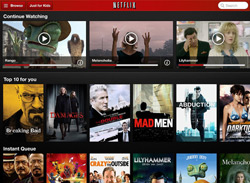Netflix Sees Surge In Tablet Viewing
- by Mark Walsh @markfwal, May 15, 2013

During the first quarter, Netflix surpassed 29 million subscribers, putting it on par with HBO’s audience. But the video streaming service didn’t provide much insight into its usage on tablets and smartphones during its conference call with analysts last week.
But new data suggests Netflix is benefiting from a surge in streaming on tablets in particular. In addition to being easily the top subscription video app -- and second only to YouTube overall in video -- it also leads in engagement, with nearly a third of total video viewing in March, according to NPD’s Connected Intelligence SmartMeter.
That translates into 2.5 hours of Netflix viewing per active tablet user a week, watching almost 45 minutes per session. Tablet viewing levels saw a significant bump starting in February, with the bulk release of all 13 episodes of “House of Cards,” Netflix’s original drama series starring Kevin Spacey.
On smartphones, the company saw a much lower share of total viewing time -- but still a sizeable chunk, at 16% in March. That amounts to less than an hour per active smartphone user weekly. People tend to favor short-form content on handsets, explaining why YouTube accounts for more than half (56%) of all video viewing time.
But Linda Barrabee, research director of NPD’s Connected Intelligence service, noted that smartphones like the iPhone 5 and Samsung’s Galaxy 4, offering larger screens and higher-resolution screens, will increasingly lead to higher engagement levels.
Netflix sees apps playing a major role in video’s future. In a position paper it posted to its investor relations board last month, the company said it expects content providers to begin programming as much for the app-based experience as for their linear programming. “House of Cards,” and other original shows like “Hemlock Grove,” and the revival of “Arrested Development” are examples of that trend from Netflix itself.
What about the impact of increased mobile video consumption on data plans and carriers? NPD points out that the tablet-based viewing shouldn’t be a big concern for carriers, since about 80% of the 60.8 million installed tablets are WiFi-only. Furthermore, the vast majority (83%) of video watching takes place in the home.
For networks, Netflix use on smartphones (Wi-Fi and cellular) is minimal, comprising only 3% of total app data usage, which is on par with YouTube.
That doesn’t mean carriers aren’t interested in working with content providers to subsidize data plans. With ESPN reportedly in talks with carriers about paying to exclude its content from subscriber data caps, it’s clear that media and telecom companies could end up sharing more of the costs of delivering video and other bandwidth-heavy services to consumers.
On Wednesday, AT&T CEO Randall Stephenson said he expects content providers and app developers to start introducing new business models that will let customers access their material without incurring high data bills.


